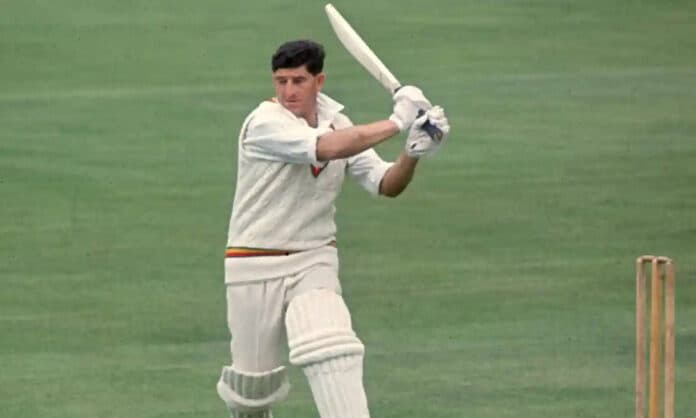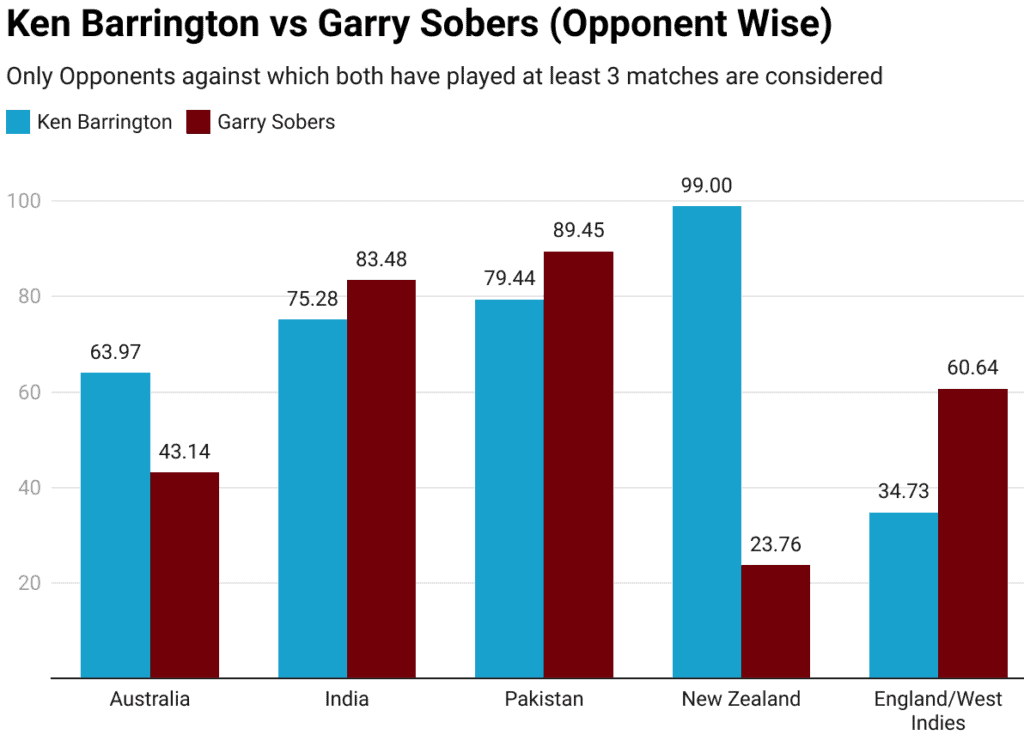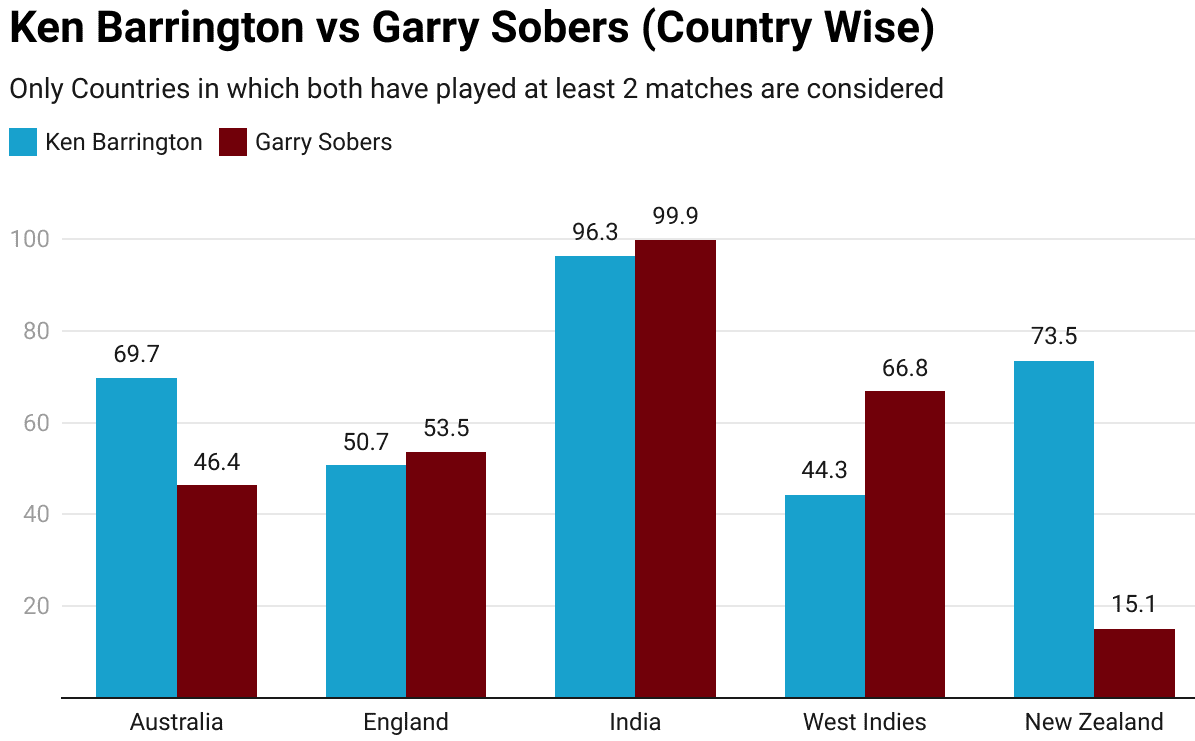When it comes to debating about the best test batter of the 60s, Sobers is usually the unanimous winner. His free-flowing, traditional calypso style of aggressive batting made him a fan favourite, and he is rated as one of the greatest batsmen of all time (quite rightly so). Well, but who’s second?
For starters, there is Garry’s teammate Rohan Kanhai, a guileful wicketkeeper-batsman. Neil Harvey, the charismatic enigma who carried on the Aussie tradition of producing world-class batsmen. There was the Phenomenal Graeme Pollock from South Africa, the Aussie Opening duo of Simpson-Lawry, and a couple of Englishmen, in the form of John Edrich, Geoff Boycott etc. Yet, amidst this elite group of men, a man from Reading, England, often does not get the appreciation he deserves.
Ken Barrington was born on 24th November 1930 to Percy and Winifred Barrington. Born amidst the Great Depression, Kenneth had an austere childhood, and his family’s army background ensured that young Ken led a disciplined life. However, his father, Percy, was an astute cricket enthusiast, having played for the regimental cricket team and taught all his children about the game.
A 15-year-old Barrington would join the Reading Cricket Club as Assistant Groundsman. A superior of his would ironically remark that Ken would never make a living in cricket. It was during this period that ex-English and Surrey cricketer Andy Sandham would scout him for Surrey.
Ken started as a leg spinner, having picked up the art at the RCC; however, Sandham felt he lacked the “accuracy” for a leggie, and moreover, Surrey already boasted both the premier spinners of the country, Tony Lock and Jim Laker. Thus Ken was suggested to concentrate more on his batting.
Barrington would take years to solidify his place in the star-studded Surrey side, finally getting his debut in 1953. Even then, it was not smooth sailing, as Barrington’s inconsistent performances meant he could never make himself stand out amongst the Greatest Surrey side of all time.
It was in 1958 that, upon advice from Alec Bedser and Jim Laker that Barrington would forgo his natural off-side dominant, attacking gameplay for a more rigid, leg-side-based defensive style. As one of the sports columns at that time would put it:
He has set out to eliminate fun from his game and replace it with something very near impregnability
This change in attitude would do wonders for him, with his average shooting up from 28.93 in the 1958 season to 58.61 in 1959. Barrington made his debut in 1955 for England, replacing injured Colin Cowdery. However, Ken would be unable to impress in his debut, and after only 2 matches, he would be dropped.
Barrington would have to wait for 4 more years to have another go at international cricket, and this time he wouldn’t disappoint. In his comeback series, Barrington would top score with 357 runs from 6 innings at an average of 59.50. From here on, there was no looking back, with Ken playing 82 of the 95 matches that England played between 4th June 1959(Ken’s 3rd match) and 25th July 1968(Ken’s last game).
His career would end on a sad note. On 12th October 1968, Ken suffered a heart attack and was admitted to Prince Henry’s Hospital. Here he was advised to cut out on smoking and do away with the mental load that cricket bought along with it. So, after careful reflection, Barrington announced his retirement from all forms of cricket on 16th January 1969.
Statistics may not be the perfect indicator for the future but are the best possible way to gauge a player of the past.
Barrington in First-Class Cricket
Barrington didn’t have First Class numbers which would put him in the bracket of all-time greats. 31,714 runs from 533 games at an average of 45.6 are outstanding numbers but fall short of fellow batting greats of that time, such as Peter May(51.0) and Bob Cowper(53.8).
Records for Ken in Surrey don’t match up with Ken, the English Batsman in England.
For Surrey, Barrington amassed 19,197 runs at an average of 41.28, whereas, In international games, his average in England shot up to 50.71.
The reason for this anomalous record of Ken is his rather dull start to his first-class career. In his first 6 years at the Club, Barrington scored 6,318 runs from 147 games at a measly average of 33.25. After his transformation in 1959, Barrington’s contribution to Surrey was 12,879 runs from 215 matches at an average of 46.83.
With all factors considered, Ken Barrington is an all-time great for Surrey. Barrington has the 10th most runs for the Lions and was a vital cog of the Greatest Surrey Side ever, winning 7 consecutive 1st division championships in the 1950s.
Ken Barrington in International Cricket
International Cricket has always been viewed as the ultimate test, and Barrington’s record for the English National Team is simply bodacious.
- 82 international games, 6,806 runs, 20 centuries, and the best score of 256, all at a staggering average of 58.67! Only Steve Smith and Bradman have more test runs at a better average.
- 3,459 runs, 14 hundreds from 36 games at an outrageous average of 69.18! No one has scored more runs away from home at a better average, and only Don has a better average away from home than Barrington (min. 1000 runs).
- Ken has a difference of +18.47 between his away and home average, only behind Mark Butcher(+20.10) and Mohinder Amarnath(+21.42) (minimum 3000 runs). The lowest Barrington’s average went in a country was the West Indies, where he averaged a solid 44.25.
- Barrington started as an opener but was moved down the middle order under his Surrey captain, Stuart Sturridge. However, Barrington showed versatility throughout his career in the context of his ability to move up and down the middle order. Barrington played nearly equal amounts of matches at positions 3,4 and 5 and performed well at all of them, with 1 down being his favourite position, averaging 77.24 over here.
- He was equally effective against all opponents. Of the 7 national teams that he played against, only West Indies troubled him, with Ken averaging 34.73 against the likes of Wes Hall, Lance Gibbs and Garry Sobers.
- Ken’s performance particularly influenced his team’s performance. Of his 20 hundreds, only 1 came in a losing cause. His average when England won was an astounding 64.42, which fell by a stupendous amount of 33.92 during the games England lost.
- Barrington finds himself at number 20 on the list of the highest career percentage of team runs(16.49%).
Ken Barrington vs Garry Sobers
I started my article with a paragraph on Sir Garry Sobers and how highly he is revered as a batsman among cricket lovers(and rightly so). Well, let’s have a comparison between Barrington and Sobers:
Suppose these graphs are presented to someone without revealing the players’ names. In that case, one is likely to conclude Barrington to be superior, or at the very least, they will be interested in a further detailed comparison. However, 50 years after both these men graced the field, one is regarded as the greatest left-handed batsman ever, while the other finds it hard to get a spot in the all-time England Test XI.
What could be the reason for such a discrepancy? Well, to start off, there’s the fact that Sobers outperformed Barrington in County Cricket. Despite joining Nottinghamshire at the fag end of his career, Sobers was simply sensational, almost single-handedly restoring the old glory of the team. Thus English Fans are likely to have fonder memories of Sobers compared to Ken (ironic, right!).
But eventually, the primary factor which has caused such a big gap between the legacies of both batters is their approach to the game. Garry Sobers personified the aggressive brand of cricket that is associated with the West Indies. Though not a natural slogger, Sober’s innings’ have been described to be elegant displays of free strokeplay, with the ability to play for greater durations of time with a constant ferocious intensity.
Ken Barrington was pretty much the exact opposite. Stout-hearted, persistent and committed are some adjectives that best describe Barrington as a batsman. Barrington started in the early 1950s, a decade considered to be one of the most challenging for batsmen. Thus one of the popular strategies among teams of that time was of batsmen going hard at the bowlers and scoring at a brisk rate. Therefore as a consequence of the era, Ken started off as an elegant stroke-maker.
Transition in Barrington’s Career
All that glitters is not gold
The above phrase best describes Barrington’s initial years, as the young 23-year-old would get off to flashy starts but could not sustain them into longer and bigger knocks. For the first 6 years of his professional career, Barrington struggled to deliver consistently; as a result, Barrington played only 2 tests in this period.
However, all of this would change in the summer of 59. Upon advice from senior Surrey players, especially Jim Laker, Barrington would instil a 180° turn in his batting approach. Sweeps, Pulls, and Leg Glances were introduced into the batting armoury. Bland leaves now replaced flashy cover drives.
The backlift was made smaller, and an obstinate aim was ingrained, “score runs”—the player who once was always searching for runs now laid “dormant” in the crease. Barrington’s poor running ability only amplified this “negative” approach to the game. However, the outcome of this change proved to be negative only for the opponents. From 1959 to 1968(his retirement), Barrington would score 24,354 runs at an average of 51.16 across all first-class games.
Ken’s performances and jovial nature meant he became a fan favourite across the globe, especially in countries like India and Australia, but he did have his share of critics, no more than in England itself. After a scrupulous 7-hour-long 137-run knock against a relatively weak New Zealand side in 1965, Barrington was dropped for the next match at Lords, becoming one of the few batsmen in cricket history to be dropped after scoring a century. No batsman scored a century other than Barrington in the match, and he would return with a 163 in the 3rd match of the series.
Ken’s slow-paced approach should not be seen as his inability to play an attacking brand of cricket. Against his favourite opponent Australia, Barrington would score a 115-ball century in 1966, taking on the bowlers when England needed quick runs.
Of the many adjectives and names, “team player” best describes Barrington. It’s true that only 8 of Barrington’s 20 test centuries resulted in England wins, but 11 of them came in draws, mostly in situations where England found themselves in a spot of bother. This statement is backed by the fact that the 1960s was the decade where England enjoyed their best ever Win/Loss ratio(barring the 1910s), the decade where Barrington was an integral part of the squad.
Barrington’s Battle with Mental Fatigue
In recent times, the aspect of the mental health of cricketers has been a hot topic among the cricket fraternity, with global superstars such as Ben Stokes and Glenn Maxwell opting for some time away from the game to look after their mental well-being. Barrington tried to do a similar thing in the 60s. Barrington would publish “Playing it Straight” in 1966, chronicling his peak and the mental fatigue he experienced during this period. Unfortunately, Ken’s efforts would go underappreciated, and currently, the book is very much forgotten.
The incident which was a major driving force behind Ken’s condition was his run-in with Charlie Griffith in the 1966 tour of the West Indies in England. Griffith was already accused of chucking by the Australians previously, and Ken seemed to agree with them on this.
Ken never liked playing against the Windies, given his rather average record against them and felt he need not fight a battle against an opponent who fought unfairly. This caused a falling out between him and the West Indian team. The series was a horror for both England and Barrington, as West Indies won the series 3-1, with Barrington scoring just 59 runs in 2 matches and opting out of the series ahead of the 3rd match, citing health issues. However, for the fighter he was, Barrington would return in the next series and again be among the top scorers.
England would tour the Caribbean beaches in 1967. Barrington calling out Griffith was still fresh among the West Indian fans, and Ken would be showered with chants such as “Charlie’s waiting for you man. He’ll kill you” in the warm-up matches. Coupled with a poor run, Barrington was so upset that he told his wife he would never tour again. But Ken fought on and played all 5 matches of the tour. Though far from the series’ best player, Barrington contributed significantly to England’s success. Scoring 288 runs at an average of 41.14 and picked up 5 crucial wickets, including a 143-run knock in the first match.
Given the incidents prior to the match, the sight of a 37-year-old Barrington, a man beaten down by the cruel nature of cricket at the highest level, a man who had always struggled against the Windies, a man who had been on the receiving end of death threats, a man unbeknownst to the fact that this will be his penultimate series, dancing down the tracks to hit Lance Gibbs for a massive six to bring up his 20th test century, must be one of the most spectacular scenes in Test history. , once remarked that:
“Whenever I saw Ken coming to the wicket I thought a Union Jack was trailing behind him.”
Wally Grout, the Australian wicket-keeper
Ken Barrington was a professional through and through. He always fought for the team, never backed down from challenges, and was a batsman whose career rightfully calls out for the tag of an All-Time Great.
But his style ensures that words like selfish, dull, boring, etc., will be associated with him forever.
Tragic, isn’t it?



